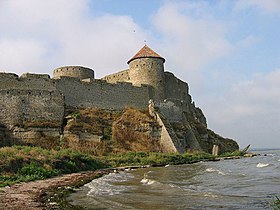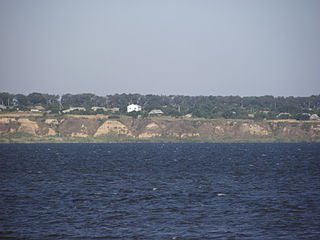
Kosivka is a village in Ukraine of Bilhorod-Dnistrovskyi Raion (sub-region) of Odesa Oblast (region). It belongs to Serhiivka settlement hromada, one of the hromadas of Ukraine. The population of the village is 258 people.

Bilhorod-Dnistrovskyi, historically known as Aq Kirmān or by other names, is a port city in Odesa Oblast, southwestern Ukraine. It is situated on the right bank of the Dniester Estuary leading to the Black Sea, in the historical region of Budjak. It also serves as the administrative center of Bilhorod-Dnistrovskyi Raion and is coterminous with Bilhorod-Dnistrovskyi urban hromada, one of the hromadas of Ukraine. It is the location of a large freight seaport. Population: 47,727.

Budjak, also known as Budzhak, is a historical region that was part of Bessarabia from 1812 to 1940. Situated along the Black Sea, between the Danube and Dniester rivers, this multi-ethnic region covers an area of 13,188 km2 (5,092 sq mi) and is home to approximately 600,000 people. The majority of the region is now located in Ukraine's Odesa Oblast, while the remaining part is found in the southern districts of Moldova. The region is bordered to the north by the rest of Moldova, to the west and south by Romania, and to the east by the Black Sea and the rest of Ukraine.

Khotyn is a city in Dnistrovskyi Raion, Chernivtsi Oblast of western Ukraine, located south-west of Kamianets-Podilskyi. It hosts the administration of Khotyn urban hromada, one of the hromadas of Ukraine. According to the 2001 Ukrainian census, it has a population of 11,124. Current population: 8,936.

Ochakiv, also known as Ochakov, and Alektor, is a small city in Mykolaiv Raion, Mykolaiv Oblast (region) of southern Ukraine. It hosts the administration of Ochakiv urban hromada, one of the hromadas of Ukraine. Population: 13,663.
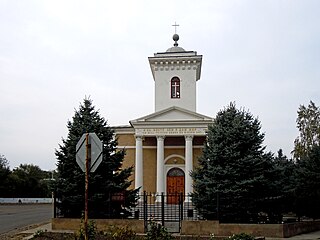
Sarata is a rural settlement in Bilhorod-Dnistrovskyi Raion, Odesa Oblast (region) of south-western Ukraine. It is a part of the Bessarabian historic district of Budjak. Sarata hosts the administration of Sarata settlement hromada, one of the hromadas of Ukraine. Population: 4,159.

Tatarbunary is a city in Bilhorod-Dnistrovskyi Raion, Odesa Oblast (province) of south-western Ukraine. It hosts the administration of Tatarbunary urban hromada, one of the hromadas of Ukraine. Tatarbunary is located north of the Danube Delta, in Budjak area, approximately 100 kilometers (62 mi) south-west of the oblast center, Odesa, close to Sasyk Lagoon. Population: 10,836.
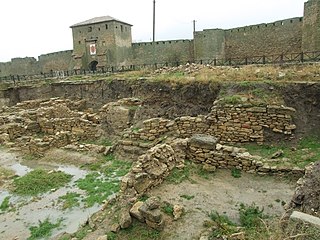
Tyras was an ancient Greek city on the northern coast of the Black Sea. It was founded by colonists from Miletus, probably about 600 BC. The city was situated some 10 km from the mouth of the Tyras River, which is now called the Dniester. The surrounding native tribe was called the Tyragetae. The ruins of Tyras are now located in the modern city of Bilhorod-Dnistrovskyi in the Odesa Oblast of Ukraine.

Yedisan was a conditional name for Özi [Paşa] Sancağı of Silistra Eyalet, a territory located in today's Southern Ukraine between the Dniester and the Southern Bug (Boh), which was placed by the Ottomans under the control of the Nogai Horde in the 17th and 18th centuries and was named after one of the Nogai Hordes. In the Russian Empire, it was referred to as Ochakov Oblast, while the Ottoman Turks called it simply Özü after the city of Ochakiv which served as its administrative center. Another name used was Western Nogai.

This is the history of Transnistria, officially the Pridnestrovian Moldavian Republic (PMR), an unrecognised breakaway state that is internationally recognised as part of Moldova. Transnistria controls most of the narrow strip of land between the Dniester river and the Moldovan–Ukrainian border, as well as some land on the other side of the river's bank.

Dniester Estuary, or Dniester Liman is a liman, formed at the point where the river Dniester flows into the Black Sea. It is located in Ukraine, in Odesa Oblast, and connects Budjak to the Ukrainian mainland. The city of Bilhorod-Dnistrovskyi lies on its western shore and Ovidiopol on its eastern shore. Shabo, situated downstream of Bilhorod-Dnistrovskyi, is known for its wine. The estuary hosts the Bilhorod-Dnistrovsky Seaport.
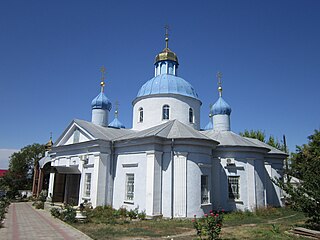
Ovidiopol is a coastal rural settlement in Odesa Oblast, Ukraine. It is located on the eastern bank of Dniester Estuary directly across Bilhorod-Dnistrovskyi and 40 km (25 mi) west of Odesa. Ovidiopol hosts the administration of Ovidiopol settlement hromada, one of the hromadas of Ukraine. Population: 11,407.

The Akkerman Convention was a treaty signed on October 7, 1826, between the Russian and the Ottoman Empires in the Budjak citadel of Akkerman. It imposed that the hospodars of Moldavia and Wallachia be elected by their respective Divans for seven-year terms, with the approval of both Powers. It also provided for the retreat of Ottoman forces from both Danubian Principalities after their prolonged stay following military actions in 1821, and Tudor Vladimirescu's uprising. The Ottomans also agreed to cede to Wallachia the control over the Danube ports of Giurgiu, Brăila and Turnu. The convention also tackled the Serbian question: in article 5, autonomy for the Principality of Serbia was given, and the return of lands removed in 1813. Serbs were also granted freedom of movement through the Ottoman Empire.

The Khotyn Fortress is a fortification complex located on the right bank of the Dniester River in Khotyn, Chernivtsi Oblast (province) of southwestern Ukraine. It lies within the historical region of northern Bukovina, a Romanian territory occupied in 1940 by the Soviet Union following the Molotov–Ribbentrop Pact. The fortress is located near another famous defensive structure, the Kamianets-Podilskyi Castle. Construction of the current stone Khotyn Fortress began in 1375. The fortress underwent significant improvements in the 1380s and in the 1460s under the Moldavian princes Alexander the Good and Stephen the Great.
This deals with the History of Transnistria before it became part of the Russian Empire in 1792.

Zatoka is a rural settlement in Bilhorod-Dnistrovskyi Raion, Odesa Oblast, in southwestern Ukraine. It belongs to Karolino-Buhaz rural hromada, one of the hromadas of Ukraine. The population of Zatoka is 1,972. Its name comes from the Ukrainian-language word zatoka, meaning "bay".
The town of Maurocastrum, also known historically as Cetatea Alba in Romanian, was a settlement on the banks of the Dniester River, now the city of Bilhorod-Dnistrovskyi, Ukraine, in the 6th century BC. It later came under successive Greek, Roman and Byzantine rule. Under the Treaty of Nymphaion of 1261, the city came under the control of the Republic of Genoa. Called Mauricastro by them, it then became a base for trading by Genoese merchants with both the Byzantine Empire and the Mongol Empire.
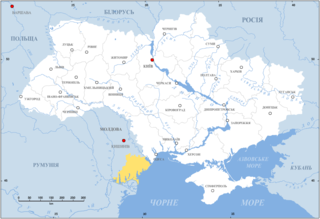
The Budjak Horde or Belgorod Horde formed part of the Nogai Horde in the 17th and 18th centuries. It settled in the northern Black Sea coast area under protectorate of the Crimean Khanate and the Ottoman Empire's Sanjak of Ozu (Yedisan). Its capital was in Căușeni.
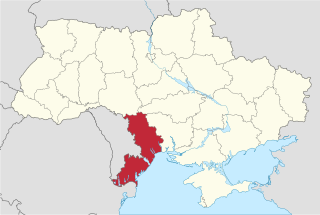
Odesa Oblast, also referred to as Odeshchyna (Одещина), is an oblast (province) of southwestern Ukraine, located along the northern coast of the Black Sea. Its administrative centre is the city of Odesa. Population: 2,351,382.
Battle of Chițcani (1683) was a battle of the united Cossack troops of the Polish-Lithuanian Commonwealth under the command of the Right-bank Hetman Stefan Kunicki and Moldavian army Ștefan Petriceicu with detachments of the Budjak Horde on 5 December 1683 during the Kunicki's expedition on the Right-bank and Moldavia at the beginning of the Polish-Ottoman War (1683–1699).
